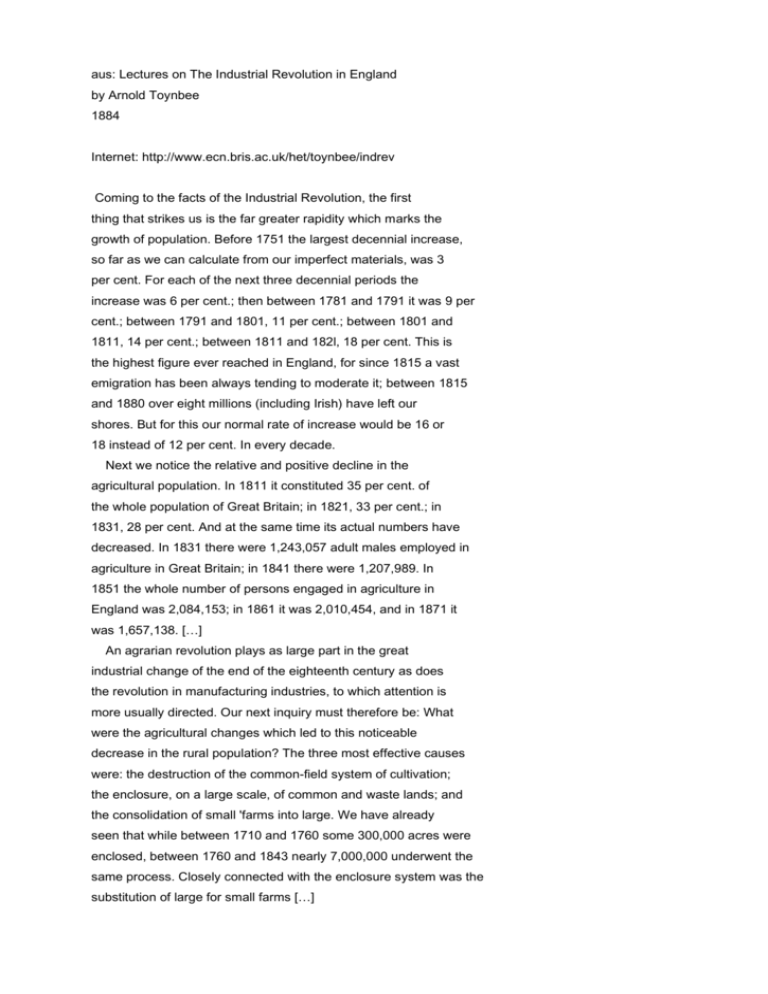aus: Lectures on The Industrial Revolution in England
advertisement

aus: Lectures on The Industrial Revolution in England by Arnold Toynbee 1884 Internet: http://www.ecn.bris.ac.uk/het/toynbee/indrev Coming to the facts of the Industrial Revolution, the first thing that strikes us is the far greater rapidity which marks the growth of population. Before 1751 the largest decennial increase, so far as we can calculate from our imperfect materials, was 3 per cent. For each of the next three decennial periods the increase was 6 per cent.; then between 1781 and 1791 it was 9 per cent.; between 1791 and 1801, 11 per cent.; between 1801 and 1811, 14 per cent.; between 1811 and 182l, 18 per cent. This is the highest figure ever reached in England, for since 1815 a vast emigration has been always tending to moderate it; between 1815 and 1880 over eight millions (including Irish) have left our shores. But for this our normal rate of increase would be 16 or 18 instead of 12 per cent. In every decade. Next we notice the relative and positive decline in the agricultural population. In 1811 it constituted 35 per cent. of the whole population of Great Britain; in 1821, 33 per cent.; in 1831, 28 per cent. And at the same time its actual numbers have decreased. In 1831 there were 1,243,057 adult males employed in agriculture in Great Britain; in 1841 there were 1,207,989. In 1851 the whole number of persons engaged in agriculture in England was 2,084,153; in 1861 it was 2,010,454, and in 1871 it was 1,657,138. […] An agrarian revolution plays as large part in the great industrial change of the end of the eighteenth century as does the revolution in manufacturing industries, to which attention is more usually directed. Our next inquiry must therefore be: What were the agricultural changes which led to this noticeable decrease in the rural population? The three most effective causes were: the destruction of the common-field system of cultivation; the enclosure, on a large scale, of common and waste lands; and the consolidation of small 'farms into large. We have already seen that while between 1710 and 1760 some 300,000 acres were enclosed, between 1760 and 1843 nearly 7,000,000 underwent the same process. Closely connected with the enclosure system was the substitution of large for small farms […] Cobbett, writing in 1826, says: 'In the parish of Burghclere one single farmer holds, under Lord Carnarvon, as one farm, the lands that those now living remember to have formed fourteen farms, bringing up in a respectable way fourteen families.' The consolidation of farms reduced the number of farmers, while the enclosures drove the labourers off the land, as it became impossible for them to exist without their rights of pasturage for sheep and geese on common lands. […] Passing to manufactures, we find here the all-prominent fact to be the substitution of the factory for the domestic system, the consequence of the mechanical discoveries of the time. Four great inventions altered the character of the cotton manufacture; the spinning-jenny, patented by Hargreaves in 1770; the waterframe, invented by Arkwright the year before; Crompton's mule introduced in 1779, and the self-acting mule, first invented by Kelly in 1792, but not brought into use till Roberts improved it in 1825. None of these by themselves would have revolutionised the industry. But in 1769-the year in which Napoleon and Wellington were born-James Watt took out his patent for the steam-engine. Sixteen years later it was applied to the cotton manufacture. In 1785 Boulton and Watt made an engine for a cotton-mill at Papplewick in Notts, and in the same year Arkwright's patent expired. These two facts taken together mark the introduction of the factory system. But the most famous invention of all, and the most fatal to domestic industry, the power-loom1, though also patented by Cartwright in 1785, did not come into use for several years, and till the power-loom was introduced the workman was hardly injured. At first, in fact, machinery raised the wages of spinners and weavers owing to the great prosperity it brought to the trade. In fifteen years the cotton trade trebled itself; from 1788 to 1803 has been called its 'golden age". for, before the power-loom but after the introduction of the mule2 and other mechanical improvements by which for the first time yarn sufficiently fine for muslin and a variety of other fabrics was spun, the demand became such that 'old barns, cart-houses, out-buildings of all descriptions were repaired, windows broke through the old blank walls, and all fitted up for loom-shops; new weavers' cottages with loom-shops arose in every direction, every family bringing home weekly from 1 2 Mechanischer Webstuhl Spinnmaschine 40 to 12O shillings per week.' At a later date, the condition of the workman was very different. Meanwhile, the iron industry had been equally revolutionised by the invention of smelting by pit-coal3 brought into use between 1740 and 1750, and by the application in 1788 of the steam-engine to blast furnaces4. In the eight years which followed this later date, the amount of iron manufactured nearly doubled itself. A further growth of the factory system took place independent of machinery, and owed its origin to the expansion of trade, an expansion which was itself due to the great advance made at this time in the means of communication. The canal system was being rapidly developed throughout the country. In 1777 the Grand Trunk canal, 96 miles in length, connecting the Trent and Mersey, was finished; Hull and Liverpool were connected by one canal while another connected them both with Bristol; and in 1792, the Grand Junction canal, 90 miles in length, made a water-way from London through Oxford to the chief midland towns. Some years afterwards, the roads were greatly improved under Telford and Macadam; between 1818 and 1829 more than a thousand additional miles of turnpike road were constructed; and the next year, 1830, saw the opening of the first railroad. These improved means of communication caused an extraordinary increase in commerce, and to secure a sufficient supply of goods it became the interest of the merchants to collect weavers around them in great numbers, to get looms together in a workshop, and to give out the warp themselves to the workpeople. To these latter this system meant a change from independence to dependence; at the beginning of the century the report of a committee asserts that the essential difference between the domestic and the factory system is, that in the latter the work is done 'by persons who have no property in the goods they manufacture.' Another direct consequence of this expansion of trade was the regular recurrence of periods of over-production and of depression, a phenomenon quite unknown under the old system, and due to this new form of production on a large scale for a distant market. These altered conditions in the production of wealth necessarily involved an equal revolution in its distribution. In agriculture the prominent fact is an enormous rise in rents. […] The high prices [of corn] of the [French] war time 3 4 Kohle aus Zechen blast = anblasen, furnaces = Hochöfen thoroughly demoralised [the farmers], for their wealth then increased so fast, that they were at a loss what to do with it. Cobbett has described the change in their habits, the new food and furniture, the luxury and drinking, which were the consequences of more money coming into their hands than they knew how to spend. Meanwhile, the effect of all these agrarian changes upon the condition of the labourer was an exactly opposite and most disastrous one. He felt all the burden of high prices, while his wages were steadily falling, and he had lost his common-rights. It is from this period, viz., the beginning of the present century, that the alienation between farmer and labourer may be dated. Exactly analogous phenomena appeared in the manufacturing world. The new class of great capitalist employers made enormous fortunes, they took little or no part personally in the work of their factories, their hundreds of workmen were individually unknown to them; and as a consequence, the old relations between masters and men disappeared, and a 'cash nexus' was substituted for the human tie. The workmen on their side resorted to combination, and Trades-Unions began a fight which looked as if it were between mortal enemies rather than joint producers. The misery which came upon large sections of the working people at this epoch was often, though not always, due to a fall in wages, for, as I said above, in some industries they rose. But they suffered likewise from the conditions of labour under the factory system, from the rise of prices, especially from the high price of bread before the repeal of the corn-laws, and from those sudden fluctuations of trade, which, ever since production has been on a large scale, have exposed them to recurrent periods of bitter distress. The effects of the industrial Revolution prove that free competition may produce wealth without producing well-being. We all know the horrors that ensued in England before it was restrained by legislation and combination.






